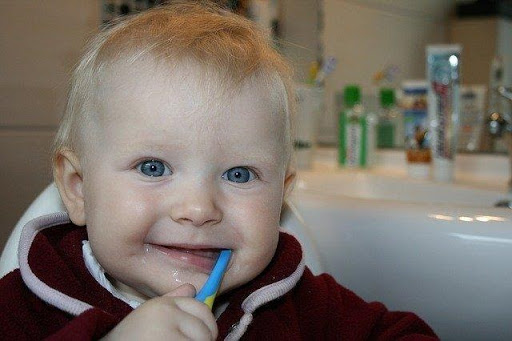Healthy Dental Habits for Children
Many milestones in early childhood are tooth-related: Teething, the first tooth popping up, the first loose tooth, and a visit from the Tooth Fairy. Although most children can brush their teeth by age six, good dental hygiene and healthy dental habits begin long before that. Teaching children how to care for their teeth and keep them healthy can prevent problems like cavities and gum disease in their early years, and avoid more serious problems in adulthood.
According to the CDC, about 20% of children ages 5 to 11 have at least one tooth with untreated decay, and 13 percent of teens have at least one untreated cavity. In addition to the discomfort that can come with tooth decay, children who don’t practice healthy dental habits can have trouble eating and speaking, as well as difficulties in school.
Starting your kids on a path to a lifetime of dental health starts with establishing healthy habits for oral hygiene, including regular visits to a family dentist, from the start. Incorporating these habits into your daily routine can help prevent cavities and maintain your little one’s beautiful, healthy smile for years to come.
Brush and Floss Regularly
Daily brushing and flossing is the key to dental health for all ages. Removing the plaque and bacteria that lead to decay prevents cavities from forming and reduces the risk of gum disease.
Children of all ages should brush at least twice a day, in the morning and at night before bed, and floss once a day. Start by using a soft infant toothbrush or silicone brush to wipe your baby’s gums after each feeding. Once they have teeth, you’ll still need to do the brushing for your little one until they have the manual dexterity to hold the brush themselves, but even then, you should supervise all kids under age six while they brush. You’ll also need to floss for them until they can manage to get in between all of their teeth.
Like adults, children should spend two minutes cleaning their teeth, getting all angles. This will require a smaller, child-size toothbrush. Only use non-fluoride toothpaste once your child is old enough not to swallow it. The dentist can show you the proper technique for brushing, but in general, use short, gentle strokes with the bristles at a 45-degree angle. Don’t forget to brush the tongue, too.
Eat Fruits and Vegetables
Maintaining a healthy diet with plenty of fruits and vegetables and limited sugary and starchy foods is good for overall health and strong, healthy teeth. Eating excess sugar feeds the bacteria that are naturally present in the mouth, causing plaque buildup. Plaque contributes to decay, and can harden into tartar that doesn’t come off with regular brushing.
Choosing healthier foods, especially crunchy fruits and veggies with a high water content, can help clean the teeth and reduce plaque buildup. This can include options like:
- Spinach
- Kale
- Carrots
- Pears
- Apples
- Celery
Limit the Use of Pacifiers and Sippy Cups
Pacifiers can be a godsend when you have a fussy infant, and sippy cups help prevent unfortunate messes, but prolonged use of either can be detrimental to your child’s teeth. Regular pacifier use after the age of two can affect the alignment of your child’s teeth and change the shape of their mouth, causing serious problems when their adult teeth come in. And while it makes sense to use a sippy cup, children who constantly have one can develop tooth decay if they are drinking sugary juices all day.
To prevent dental issues, limit the use of pacifiers and help your child develop other self-soothing techniques. Keep sippy cups to meal and snack times, and only fill them with water or milk with meals. Work on learning to use regular glasses sooner rather than later to prevent the need for orthodontics or cosmetic dentistry in the future.
Make Dental Hygiene Fun
Daily dental hygiene can be fun! When you make the task exciting, kids can enjoy taking care of their teeth. Some of the ways to do this include:
- Letting them choose a toothbrush with a favorite character or design.
- Reading books or watching shows about dental care or visiting the dentist to take the mystery out of the experience and make it more relatable.
- Playing music to help them brush for the right amount of time.
- Singing songs or playing games to get them excited about brushing.
- Playing dentist. Use a small play dental kit to practice on favorite stuffed animals or dolls, or let your child look at your teeth.
Reward Good Dental Habits
Children thrive on positive reinforcement, so make good dental habits a positive experience by rewarding them for taking care of their teeth. Keep track of their daily brushing and flossing with stickers, and give them a reward when they collect a certain number of stickers. Giving rewards for cavity-free dental visits and stopping or avoiding bad habits like chewing on their pencil or nail-biting can encourage positive habits and healthy teeth.
Avoid making anything dental health-related a punishment or creating negative associations with the dentist or dental care. Children shouldn’t be taught to see flossing or a dentist appointment as punishment, as that can contribute to lifelong anxiety about dental care.
Visit Your Family Dentist Regularly
Pediatricians recommend making an appointment to see the dentist as soon as your child’s first tooth appears, or at age one, whichever comes first.
All children should visit their family dentist for an exam and cleaning twice a year. Some children may need more frequent visits if additional care is necessary. Many parents keep the entire family on the same schedule to make it easy to remember and ensure no one misses appointments. Choose a dentist experienced in working with all ages, who can make your child feel comfortable and relaxed, and make the experience a pleasant one.
Related Links:

